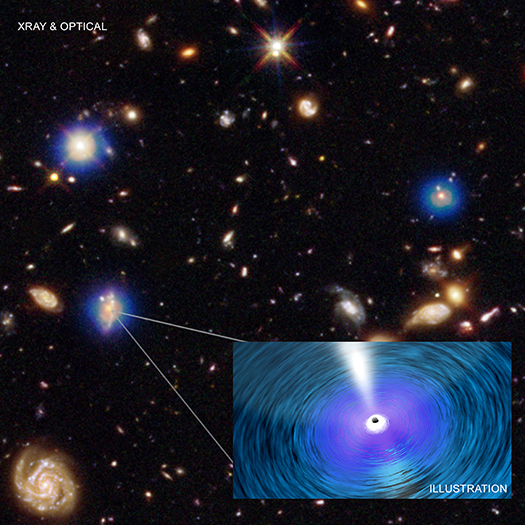The Billion-year Race Between Black Holes and Galaxies: Mar Mezcua

Mar Mezcua
Mar Mezcua is a postdoctoral researcher at the Institute of Space Sciences, in Barcelona (Spain), where she is from. She is a guest blogger today and the leading author of one of the two papers highlighted in our latest press release. aShe conducted this work last year with Prof. Julie Hlavacek Larrondo while at the University of Montreal (Canada).
Supermassive black holes (SMBHs) started to fascinate me when I was 13 years old. These monsters reside at the center of massive galaxies and are the most energetic sources in the Universe. When they are actively accreting, the surrounding matter that feeds them (or that the black hole accretes) can radiate over a trillion times as much energy as the Sun, being able even to outshine the galaxy in which they reside. This feeding, or accreted, material emits X-ray radiation that we can detect with X-ray satellites such as Chandra, while the material that is ejected from the SMBH in the form of jets also often emit at radio wavelengths. (Yes, SMBHs do not only swallow but also emit outflows of energetic particles!) It is for all the above that I pursued a career in astrophysics in order to study these powerful behemoths in detail.
My first close approach took place during my PhD, when I estimated the black holes (BH) masses of a sample of SMBHs whose radio jets had a peculiar morphology. To do this, I used the close relationships that had been recently found between the mass of SMBHs and some of their host galaxy properties, such as how much light was emitted by the central bulge or how quickly and where the stars in the bulge moved.
The finding of such correlations suggested that SMBHs and their host galaxies grow in tandem — that there is a co-evolution — implying that SMBHs somehow regulate the growth of the galaxy in which they reside. As simple as it might sound, this was an astonishing discovery of the late 90’s. SMBHs typically have masses of between one million and one billion times that of the Sun and sizes similar to that of the Solar System, this is, nearly 10,000 times smaller than the galaxy that hosts them. That’s a huge difference in size! How is it then possible that such a ‘small’ central SMBH controls the whole budget of a galaxy? SMBHs were getting more and more exciting every time, so after my PhD I kept on studying them using all tools I had available: radio, optical, infrared and X-ray observations!
I started to understand that the SMBH-galaxy synchronized growth can be explained by the effects of the outflows or jets ejected by the SMBH, which penetrate the host galaxy and can hamper (but can also trigger) the formation of stars and thus of stellar mass. The most extreme examples of such SMBH feedback are found in galaxy clusters, which host the brightest and most massive galaxies of the local Universe. So when Prof. Julie Hlavacek Larrondo offered me the possibility to move to Montreal to study SMBHs in galaxy clusters with her, I didn’t hesitate!
The SMBHs of such brightest cluster galaxies emit radio jets that extend beyond the host galaxies. These jets enter the hot gas that permeates the space between the galaxies in the cluster, opening cavities in this X-ray emitting medium. The brightest cluster galaxies are elliptical galaxies that reside at the intersection of filaments of dark matter — ie material that makes up the bulk of matter in the Universe — in very dense environments, and are thus subject to conditions very different from those of isolated galaxies.
This raised some pressing questions that intrigued us: Do the brightest cluster galaxies and their SMBHs then follow the same co-evolutionary galaxy/SMBH growth as other galaxies? Is the ratio between the growth rates of SMBHs and their host galaxies the same at the high-mass end, where brightest cluster galaxies are located, as it is at lower masses? In other words, is the BH/galaxy scaling relation the same? To probe this, we investigated the location of the brightest cluster galaxies on the “fundamental plane” of BH accretion, which is an empirical correlation supported by the theoretical expectation that BH accretion is a universal mechanism governing BHs of all masses. This fundamental plane correlates the mass of a BH with its nuclear X-ray luminosity and the radio luminosity of the core of its radio jet, and has been found to be valid both for stellar-mass BHs and SMBHs, thus unifying BHs across all mass scales. It is called a plane because that describes the shape of the relationship in three dimensions.
Together with other collaborators from the University of Waterloo and Durham University, we took a sample of brightest cluster galaxies that had been observed by Chandra as well as by the major radio telescope arrays in the world. This gave us the SMBHs’ X-ray and radio luminosity, that is the amount of radiation produced. Assuming that the SMBHs followed the correlation between BH mass and bulge luminosity found for massive galaxies, we estimated their BH mass from the luminosity of the host galaxy and then located them on the fundamental plane of BH accretion using this BH mass, the nuclear X-ray luminosity and the core radio luminosity.
And, surprise!! We found that the brightest cluster galaxies were on average offset from the fundamental plane by about a factor of 10, that is, the masses of their SMBHs were found to be higher than expected if the SMBHs followed the fundamental plane correlation! We investigated several possible explanations of this offset, and found that it did not seem to be caused by cooling of the radio jet. Nor does it appear to be a type of emission process assumed in the derivation of the fundamental plane correlation, among others.
The offset of brightest cluster galaxies from the fundamental plane seemed to be due to the BH mass being underestimated, by the aforementioned factor of about 10, by the correlation between BH mass and bulge luminosity. In other words, the brightest cluster galaxies seem to be more overmassive than expected with respect to the SMBH-galaxy relations. This had been already suggested for a few brightest cluster galaxies for which accurate measurements of their SMBH masses revealed masses larger than predicted from the correlation between BH mass and stellar velocity dispersion, and implies that the BH-galaxy scaling relations do not hold for these extreme objects.
That was a very exciting discovery for me, as just two years before I had found similar results for another type of elliptical galaxies (of smaller size and not located in galaxy clusters). So all together we seemed to be breaking down the sovereignty of BH-galaxy scaling relations!
But wait, there’s still more! For the brightest cluster galaxies to, on average, follow the fundamental plane, a large fraction of them should have SMBHs with masses more than 10 billion times that of the Sun. This means they host “ultramassive” BHs. So now you might wonder, (as I did, you should!): how did such beasts form? One possibility is that they underwent a two-phase process in which the BH formed first very rapidly and the galaxy grew later at a slower pace, which defiantly challenges the current paradigm of a synchronized galaxy-BH growth. Alternatively, the SMBHs in the brightest cluster galaxies might be the descendants of the high-redshift, or very distant, seed BHs, invoked to explain the existence of SMBHs when the Universe was only about 0800 million years old. In this scenario, black holes would have grown via mergers following a standard hierarchical process.
And guess what? As part of a different project in collaboration with the Harvard-Smithsonian Center for Astrophysics, I was (and still am!) precisely studying the presence of such seed BHs in dwarf galaxies also using Chandra data! Two independent projects, two different types of galaxies, but both related somehow to the first BHs formed in the early Universe! Astronomy doesn’t stop surprising me every day, which is what makes doing research so exciting!
- Log in to post comments

